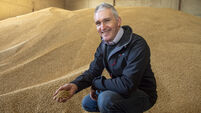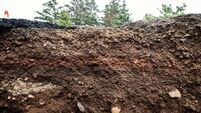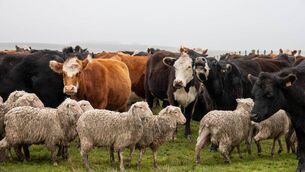AD as part of the 25% by 2030 solution

As part of its climate plan, the Irish Government has set a target of producing 5.7 terawatt-hours of biomethane by 2030, which is the equivalent of 10% of Ireland's current demand for natural gas.
Farmers, farm organisations, and agricultural co-ops have been advised to take a key role in developing anaerobic digestion (AD) in Ireland.
“We can sit on our hands and do nothing, and let someone else come in and build these plants, or farmers can get active”, said Dr Maurice Deasy, researcher on Teagasc's FLEET evaluation of the potential of AD for farmers.
In a recent episode of the Signpost Series podcasts, he said if AD plants are built and operated by farmers, they will benefit farmers.
As part of its climate plan, the Irish Government has set a target of producing 5.7 terawatt-hours of biomethane by 2030, which is the equivalent of 10% of Ireland's current demand for natural gas. There is an interim target of 1 TWh by 2025.
Biogas from AD plants can be upgraded to biomethane, which can then be used as a direct replacement for natural gas. Biomethane can also be used as CNG fuel for trucks. The carbon dioxide by-product can be used in the food and beverage industry.
The government is due to announce a National Biomethane Strategy for the agriculture sector to deliver on its sectoral emissions reduction target, for businesses to decarbonise, and Ireland to meet its EU renewable heat targets.
Biomethane can help farmers on the double to reach their obligation to reduce emissions 25% by 2030 (relative to 2018).
“Our slurry tanks and slatted sheds contribute to our emissions of methane. If we were taking that slurry out of agriculture and digesting it, capturing that methane, that would help reduce our emissions”, said Dr Deasy.
“Typically in Germany, a lot of maize is used, in the UK you’ve got beet and wholecrop, but also grass. In an Irish context, we’re talking a lot more about grass, because 90% of the agricultural area is grassland and equally, we think we can produce grass without chemical nitrogen which is important in terms of sustainability”, explained the FLEET researcher (Farm Level Economic, Environmental and Transport Modelling of AD).
Teagasc is investigating the use of red-clover silage and multispecies swards for AD plants. Ireland is unique across Europe in producing high yields from grass silage, and the use of legumes such as clover would reduce or eliminate the requirement for nitrogen fertiliser. Some of the current issues with clover swards around rotational grazing, longer rest periods, higher residuals, or fear of bloating, do not arise if the clover sward is being produced as an AD feedstock.
If contrast, if chemical nitrogen is used to grow silage for an AD plant, it reduces the environmental sustainability of the biomethane. “Chemical nitrogen has a huge emission that needs to be accounted for in RED 2”, Dr Deasy explained. RED 2 is the Renewable Energy Directive which requires all EU Member State fuel suppliers to supply at least 14% renewable transport fuels by 2030.
Under this Directive, animal slurries are given a manure credit for the capture of methane that would otherwise be lost to the atmosphere.
Biogas from AD plants is usually converted to heat and power. The electricity can be sold to the grid, and the heat can be used, for instance, to heat a poultry unit, or a cheese processor. In Germany, AD plants often supply district heating systems. “An AD plant is running 24 hours a day, the bugs are always making gas. That creates a power that you can actually store and use when you want it, which is a big difference from solar and wind”, said Dr Deasy. Hence, AD power could be sold at a premium, when demand is highest. However, there are no schemes as yet set up in the Republic of Ireland to sell AD power to the grid.
And how willing might Irish farmers be to supply silage to an AD plant? Finding the answers to that question was part of the FLEET research.
“Most farmers, nearly 65%, were saying ‘no, I wouldn’t supply silage to an AD plant” said Dr Deasy. “I think a lot of that is down to awareness. If you don’t know what AD is, and you’re asked would you supply an AD plant, you’d say, well, ‘no, because I don’t know what an AD plant is’”.
On the other hand, 15% of farmers indicated that they would consider it, if the market price was right. “That’s actually probably enough farmers to supply 5.7 TWh, and 10% of the gas grid. We don’t need every farmer to do this in terms of supplying grass. We need a small amount of farmers to supply grass”.
There was general readiness among farmers to receive the digestate organic fertiliser by-product from AD plants.
But slurry would be needed from many more than 15% of farmers. Usually, AD plants use a a 50/50 blend on a fresh weight basis of silage and slurry.
“Eighty percent of the power would be coming from the silage, 20% coming from the slurry, or even less” said Dr Deasy. If RED 2 targets are to be met, silage cannot be used 100% in a AD plant, because of the associated emissions, such as from diesel for harvesting. Using the slurry offsets those emissions, because of the extra bonus of capturing the slurry methane otherwise lost to the atmosphere. An AD plant will not want watery slurry, advised Dr Deasy.
“Fibre doesn’t make biogas either, so those big, high yields of lignocellulose silage which is very good for feeding a suckler cow, very good for the rumen health, that’s not what an AD plant wants”, he added.
The FLEET researchers assessed the profitability of selling silage for €30 to €40 per tonne. Dairy would always be more profitable. But at €40 a tonne, one could possibly make more from AD silage than from tillage. “On average, it’s not very likely that a tillage farmer would go towards growing grass for AD”, Dr Deasy said.
“For your sheep and cattle enterprises, once the price of the AD silage gets to €40 a tonne, then it does look to be more economically viable to sell grass for AD compared to your existing system. There has to be increased profitability, to make a farmer shift over from one system to another, otherwise why change, why take the risk?” he said.
“I think AD has a role in achieving some of our greenhouse gas emission savings, particularly from our slurry from ruminants”, Dr Deasy said. “If a farmer has too many cows, here’s an opportunity. You could sell your artic load of slurry, you can get your certificate. Now you’ve reduced your organic loading”.
On a dairy farm, about 10% of emissions would typically be associated with the slurry tank, which is emitting methane.
“The advantage of AD is that if you are taking that slurry out of the farm, exporting it to an AD plant, capturing that methane, now we can use that as an energy source”.
The slurry would be collected as fresh as possible.
Dr Deasy favours a system which would incentivise farmers to produce both food and energy. If farmers can grow more grass than they can feed to cows, the excess could be used to supply AD plants, diversifying farm income. AD also will create considerable rural employment, since it involves three or four cuts of silage, managing slurry, distributing digestate, etc.
The digestate fertiliser from AD plants is typically 6-8% dry matter, like livestock slurry. However, the fertiliser value is increased, particularly the plant-available nitrogen. And digestate has a verified nutrient content.
”You have more nitrogen and it’s more available, so you get a much better crop response,” Dr Deasy said.
If a farmer supplying feedstock doesn’t need the digestate back, they can receive a credit instead, and someone else will use the digestate. Arable farms, in particular, will greatly value this fertiliser.
Northern Ireland and the UK already have many AD plants. Pig slurry, food waste, industrial waste, are all very good feedstocks, but they are limited resources. “The big potential in terms of reaching the big numbers is in cattle slurry and grass silage,” said Dr Deasy.
Teagasc Grange is the site of a pilot AD plant. Per day, it will need about 10 tonnes of grass silage at 25% dry matter and nearly 15 tonnes of slurry. It will need silage from about 70ha, and the winter slurry from 1,000 cattle.
The plant will produce about 3.2 Gigawatt hours of energy per year. However, much larger (20 to 30 GWh) plants, fed primarily on agricultural materials, are expected. Such a plant would need about 100 tonnes of silage a day, and 150 tonnes of slurry.













